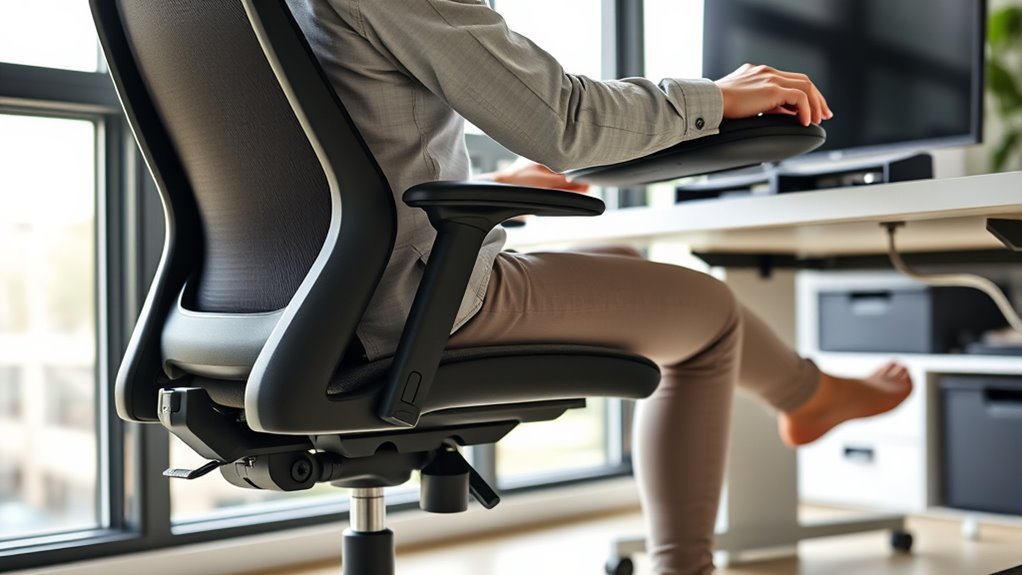To prevent back pain, focus on maintaining good posture and practicing ergonomic habits. Keep your monitor at eye level, support your lower back with a chair or lumbar cushion, and keep your feet flat on the floor. Avoid slouching or staying in one position too long—take regular movement breaks and stretch. Using supportive furniture and standing correctly can make a big difference. Keep exploring to discover more tips to protect your spine every day.
Key Takeaways
- Maintain proper sitting and standing postures by keeping feet flat, knees at 90°, and shoulders relaxed to reduce back strain.
- Adjust your workspace ergonomically by aligning monitors at eye level and supporting the lower back with appropriate chairs or cushions.
- Take regular breaks to stretch, move, and change positions, preventing muscle stiffness and promoting spinal health.
- Incorporate core strengthening exercises and dynamic stretches to stabilize the spine and improve flexibility.
- Use ergonomic accessories like footrests and lumbar cushions to support natural spinal curves and reduce pressure on back muscles.
Understanding the Impact of Poor Posture on Your Back

Poor posture can considerably strain your back muscles and spine, leading to discomfort and long-term issues. When you slouch or lean improperly, it creates muscle imbalance, where some muscles become overstretched while others tighten. This imbalance disrupts your spinal alignment, causing your vertebrae to shift from their natural position. Over time, this misalignment increases stress on your spinal discs and joints, raising the risk of chronic back pain. Poor posture also forces your muscles to work harder to support your body, leading to fatigue and further imbalance. Recognizing how poor habits affect muscle strength and spinal positioning helps you understand the importance of maintaining good posture for long-term back health. Implementing proper ergonomics and correct posture can significantly reduce the strain on your back muscles and prevent structural problems. Early correction of poor posture can help maintain proper spinal alignment and avoid muscle imbalance, which is a common contributor to back pain. Additionally, incorporating mindfulness techniques such as body awareness can help you develop better posture habits and reduce the risk of discomfort. Regularly practicing ergonomic adjustments and being mindful of your posture habits further support long-term back well-being. Moreover, understanding the impact of poor ergonomics in daily activities can guide you in making healthier choices to protect your back health.
Essential Ergonomic Practices for Your Workspace

Maintaining proper ergonomics in your workspace can considerably reduce the strain on your back muscles and help prevent long-term discomfort. Start with an ergonomic assessment to identify any poor habits or setups. Adjust your workstation setup so your monitor is at eye level, and your chair supports your lower back. Keep your feet flat on the floor or on a footrest, and ensure your knees are roughly at a 90-degree angle. Position your keyboard and mouse close enough to prevent reaching, which can strain your shoulders and back. Take regular breaks to stretch and change positions. Incorporating proper workspace layout can further enhance your posture and reduce discomfort. Using ergonomically designed office tools can also make a significant difference in maintaining a healthy posture. Additionally, paying attention to body mechanics throughout your workday helps in maintaining optimal spinal alignment. By optimizing your workstation setup and performing routine assessments, you create a healthier environment that supports your spine and reduces the risk of back pain.
Proper Sitting and Standing Techniques to Protect Your Spine

To protect your spine while sitting or standing, it’s essential to use proper techniques that promote good posture and reduce strain. When sitting, keep your feet flat on the floor, knees at a 90-degree angle, and your back firmly supported by the chair’s lumbar curve. Engage in core strengthening exercises to stabilize your spine and reduce pressure. When standing, distribute your weight evenly on both feet, keep your shoulders relaxed, and avoid locking your knees. Focus on breathing techniques that promote relaxation and proper posture, such as deep diaphragmatic breathing, to help maintain alignment. Regularly check your posture throughout the day and make small adjustments as needed. Incorporating ergonomic principles into your workspace setup can further enhance spinal health and prevent discomfort. Maintaining awareness of your body alignment throughout daily activities can significantly reduce back strain. Using these techniques will help minimize back pain and support long-term spinal health.
Incorporating Movement and Stretching Into Your Daily Routine

Incorporating movement and stretching into your daily routine is essential for maintaining spinal health and preventing back pain. Dynamic stretching helps loosen tight muscles and improves blood flow, making your movements more efficient and reducing strain. Set aside time for simple stretches, like shoulder rolls or gentle twists, to keep your muscles flexible. Pay attention to posture awareness throughout the day—standing tall and avoiding prolonged static positions promotes better spinal alignment. Break up long periods of sitting with quick movement breaks, and include stretching exercises that target your back and hips. Consistent movement keeps your muscles active and resilient, reducing the risk of pain and injury. Incorporating movement habits into your routine can significantly enhance your overall spinal health and prevent discomfort over time.
Choosing Supportive Furniture and Accessories for Back Health

Choosing the right furniture and accessories can considerably improve your back health by providing proper support and promoting good posture. An ergonomic chair supports your lower back, encouraging proper spinal alignment. Adding a supportive cushion to your chair or seat can reduce pressure on your hips and lumbar region. Visualize these options:
| Furniture/Accessory | Function | Benefit |
|---|---|---|
| Ergonomic chair | Supports spine’s natural curve | Prevents slouching, reduces strain |
| Supportive cushion | Adds lumbar or seat support | Eases pressure, improves posture |
| Adjustable desk | Ensures proper height | Keeps monitor eye level, reduces neck strain |
| Footrest | Elevates feet comfortably | Promotes circulation, reduces pressure |
| Lumbar pillow | Provides targeted lower back support | Maintains spinal alignment |
Furthermore, selecting proper ergonomics can prevent long-term back issues and enhance overall comfort during daily activities. Incorporating ergonomic principles into your workspace setup is essential for maintaining good back health over time.
Frequently Asked Questions
How Does Sleep Position Affect Back Pain Prevention?
Your sleep position considerably impacts back pain prevention by influencing sleep alignment. Sleeping on your back or side helps maintain proper spinal alignment, reducing strain. Make certain your mattress choice supports your preferred sleep position—firm enough to keep your spine aligned yet comfortable. Avoid stomach sleeping, which can twist your neck and back. By choosing the right mattress and sleep position, you support your back’s health and minimize pain chances.
Can Specific Exercises Improve Posture and Reduce Back Discomfort?
Did you know that regular exercise can reduce back pain by up to 25%? Yes, specific exercises like core strengthening and flexibility exercises can improve your posture and decrease discomfort. By targeting muscles that support your spine, you enhance stability and mobility. Incorporate these exercises into your routine consistently, and you’ll likely notice less back pain and better posture, helping you stay active and pain-free longer.
What Are Signs of Ergonomic Mistakes Causing Back Issues?
You might notice discomfort, stiffness, or persistent soreness in your back, which can signal ergonomic mistakes. If your office chair lacks proper lumbar support, it can strain your lower back. Poor posture while sitting, such as slouching or leaning forward, also contributes. Pay attention to these signs; adjusting your office chair for better lumbar support and maintaining correct posture can help prevent back issues caused by ergonomic errors.
How Often Should I Take Breaks to Protect My Back?
Imagine your workspace as a well-oiled machine, needing breaks to stay efficient. You should take a break every 30 to 60 minutes, standing up and stretching your muscles. Incorporate simple stretching routines during these pauses to relieve tension. Adjust your desk setup to keep your back supported, and avoid staying in the same position too long. Regular breaks help protect your back and keep you comfortable throughout the day.
Are There Ergonomic Solutions for People With Limited Mobility?
You might wonder if ergonomic solutions exist for limited mobility. Yes, there are assistive devices and adaptive furniture designed to support your posture and comfort. These tools help you maintain proper alignment, reduce strain, and make daily tasks easier. By customizing your environment with ergonomic equipment, you can prevent discomfort and promote better back health, even with mobility challenges. Always consult with a specialist to find the best options for your needs.
Conclusion
By mastering good posture and ergonomics, you’re practically turning your back into a super-powered shield against pain. Imagine your spine as a mighty fortress, standing tall and proud with every correct sit and stretch. Just a little effort each day transforms your workspace into a pain-free paradise. So, embrace these habits—your back will thank you with a lifetime of pain-free adventures. Get ready to conquer the day, pain-free and unstoppable!










